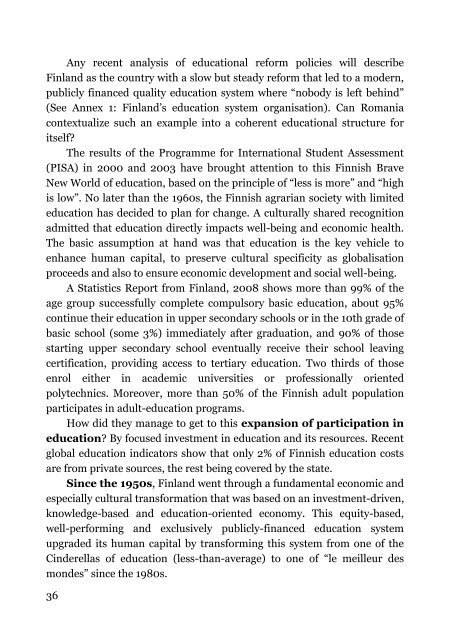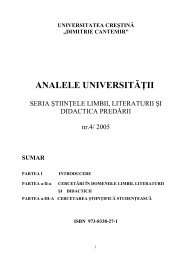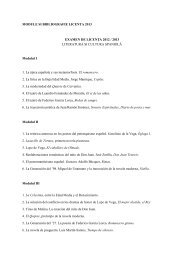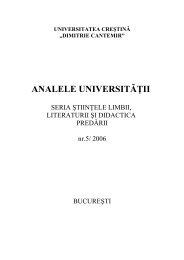analele universităţii - Facultatea de Limbi Straine - Dimitrie Cantemir
analele universităţii - Facultatea de Limbi Straine - Dimitrie Cantemir
analele universităţii - Facultatea de Limbi Straine - Dimitrie Cantemir
Create successful ePaper yourself
Turn your PDF publications into a flip-book with our unique Google optimized e-Paper software.
Any recent analysis of educational reform policies will <strong>de</strong>scribe<br />
Finland as the country with a slow but steady reform that led to a mo<strong>de</strong>rn,<br />
publicly financed quality education system where “nobody is left behind”<br />
(See Annex 1: Finland’s education system organisation). Can Romania<br />
contextualize such an example into a coherent educational structure for<br />
itself?<br />
The results of the Programme for International Stu<strong>de</strong>nt Assessment<br />
(PISA) in 2000 and 2003 have brought attention to this Finnish Brave<br />
New World of education, based on the principle of “less is more” and “high<br />
is low”. No later than the 1960s, the Finnish agrarian society with limited<br />
education has <strong>de</strong>ci<strong>de</strong>d to plan for change. A culturally shared recognition<br />
admitted that education directly impacts well-being and economic health.<br />
The basic assumption at hand was that education is the key vehicle to<br />
enhance human capital, to preserve cultural specificity as globalisation<br />
proceeds and also to ensure economic <strong>de</strong>velopment and social well-being.<br />
A Statistics Report from Finland, 2008 shows more than 99% of the<br />
age group successfully complete compulsory basic education, about 95%<br />
continue their education in upper secondary schools or in the 10th gra<strong>de</strong> of<br />
basic school (some 3%) immediately after graduation, and 90% of those<br />
starting upper secondary school eventually receive their school leaving<br />
certification, providing access to tertiary education. Two thirds of those<br />
enrol either in aca<strong>de</strong>mic universities or professionally oriented<br />
polytechnics. Moreover, more than 50% of the Finnish adult population<br />
participates in adult-education programs.<br />
How did they manage to get to this expansion of participation in<br />
education? By focused investment in education and its resources. Recent<br />
global education indicators show that only 2% of Finnish education costs<br />
are from private sources, the rest being covered by the state.<br />
Since the 1950s, Finland went through a fundamental economic and<br />
especially cultural transformation that was based on an investment-driven,<br />
knowledge-based and education-oriented economy. This equity-based,<br />
well-performing and exclusively publicly-financed education system<br />
upgra<strong>de</strong>d its human capital by transforming this system from one of the<br />
Cin<strong>de</strong>rellas of education (less-than-average) to one of “le meilleur <strong>de</strong>s<br />
mon<strong>de</strong>s” since the 1980s.<br />
36







